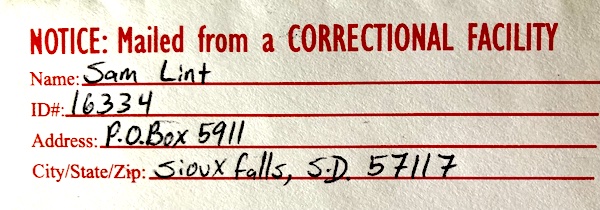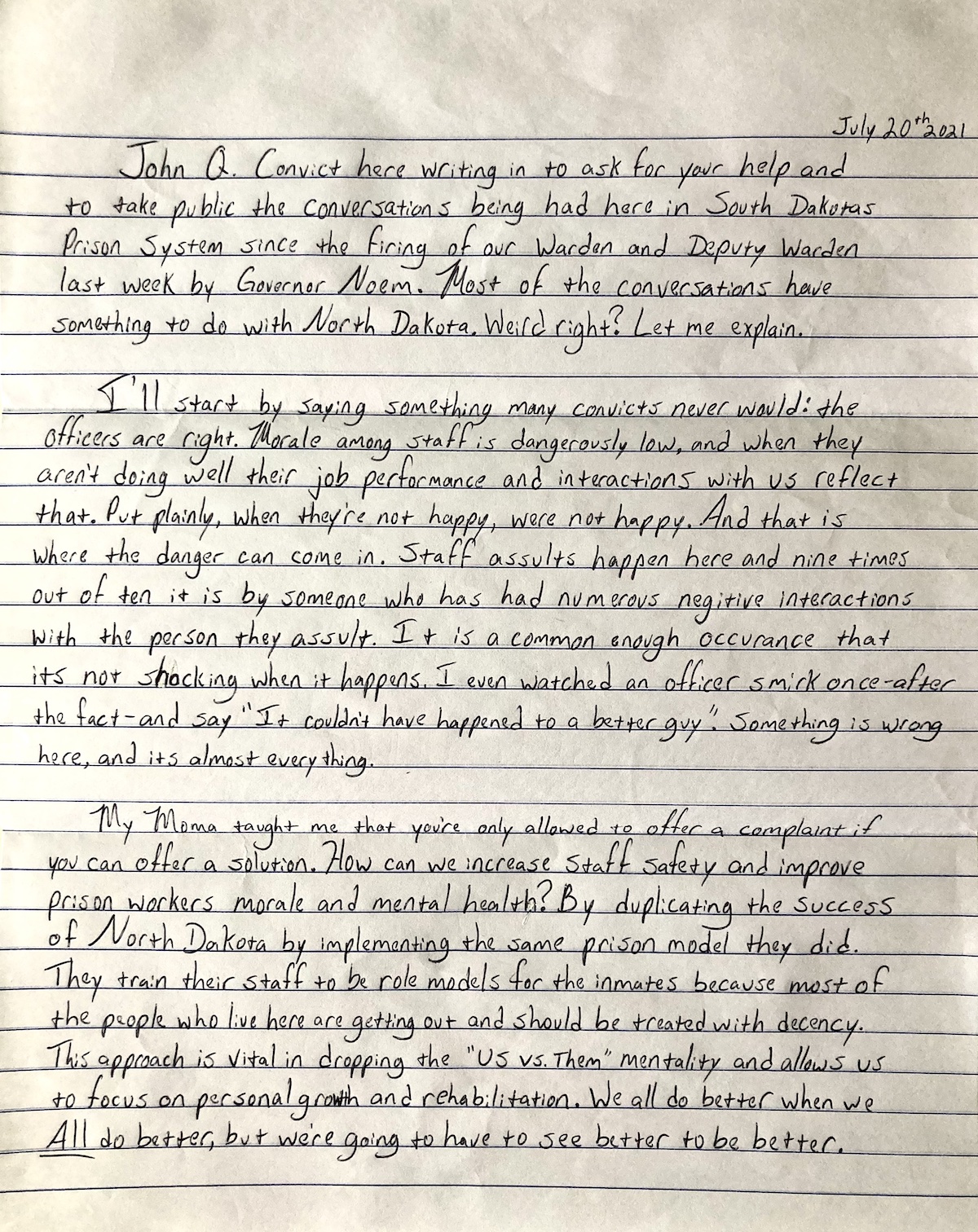Is there something about living in South Dakota that helps me think like a prisoner?
I hit “Publish” on my last article, on North Dakota’s Norway-inspired prison reforms, went out to get my mail, and found this letter from Samuel Lint, inmate #16334 at the South Dakota State Penitentiary, dated July 20, postmarked July 27.

Mr. Lint is serving a life sentence in the Pen. He has written before to share his observations on prison life and how South Dakota might improve its correctional system. He writes again this month in response to the firing of his warden and deputy warden and offers the same suggestion I just blogged: to make inmates and prison staff safer and healthier, South Dakota should follow North Dakota’s example in pivoting its prisons from punishment to rehabilitation:


Lint says “most of the conversations” he hears within South Dakota’s prison system since the Governor fired the warden and deputy warden “have something to do with North Dakota.” That suggests it’s not just one inmate and one blogger thinking along these lines; perhaps South Dakota prison staff and political leaders are reading the news and preparing their own trip across the border to see what they can learn from our northern neighbors about safe, effective, rehab-oriented prisons.
While the anonymous complaint and Governor Kristi Noem’s statement on South Dakota prison conditions have focused on staff safety, Lint reminds us that low morale among staff poses safety risks to prisoners, too. Lint says dispirited staff take their frustrations out on inmates. No matter how little sympathy we may have for criminals, their sentences do not include regular snot-knockings by guards; such violence violates inmates’ remaining civil rights and only makes it harder for convicts to overcome their own issues and leave prison as peaceful, law-abiding citizens. As Lint’s neighbor behind bars, inmate Damion Williams, wrote in June, rehab requires guards who model the values we are trying to instill in inmates—”empathy, respect, caring for others.” As Lint says here, North Dakota trains its prison staff “to be role models for the inmates” and treat their wards “with decency. This approach is vital in dropping the ‘us vs. them’ mentality and allows us to focus on personal growth and rehabilitation.”
Will South Dakota’s new prison leaders look to North Dakota to make our prisons safer for staff and inmates alike? Or will the Governor’s hand-picked replacements, so far all members of the “old guard”, see a focus on rehab as too soft, as a threat to the hierarchy to which they are accustomed, and reject any real paradigm shift for our prisons?
I hope SD does the right thing and follows what the ND prison system has learned from the Scandinavian prison system, but…I do not think most South Dakotans, especially our Governor, believe prisons are a place for rehabilitation but rather a place for punishment. Hence nothing will change unless something tragic happens. There is a bit of hope and gloom.
To make this change requires a tremendous commitment from the Governor on down through the system. Many people will resist the change at all levels. The change will require a commitment of resources, fiscal and human, and a tremendous amount of energy.
I highly recommend watching “Breaking the Cycle”, a documentary about Halden Prison in Norway and how they helped North Dakota develop their sister system, along with a visit to the New York prison system. It really shows how human rehabilitation, and humane treatment, of inmates is necessary simply because most prisoners will get out at one point or another. Do you want them to come out violent, addicted, uneducated and/or untrained? Or do you want them rehabilitated, with hope for the future within society?
Also, if any of the readers here would like to actually visit the South Dakota State Prison – and can pass a background check – leave me some contact info. I’ve volunteered for 11 years at the prison for the Alternatives to Violence Project (we can always use more volunteers!) and the Lifer’s Group.
Thanking Eve Fisher for her volunteer work at the joint.
Happy to do it, Porter. Wish more people would, it would help with rehabilitation and communication.
I’ve been working with the leadership of the ND Prison System on a project at work – their system is legit.
Not only do they focus on rehabilitation while you’re in prison, they incarcerate are a much lower rate, instead diverting money they were going to spend on building a new prison into a program called Free through Recovery which pays for private case management and peer support with the goal of improving engagement with parole and probation, securing a job and stable housing, limiting interactions with law enforcement, and engaging in treatment. Participants get to choose the organization that will best suit them and their priority needs, whether that’s a church based program, a formal treatment program, a healthcare provider, a social work program that are signed up as providers. The outcomes have been great so far for many and have prevented the prison system from being filled with low risk or otherwise nonviolent inmates.
There is also a good felony expungement program as well.
The overall vision is that almost everyone in the prison system will re-enter society, so let’s give them the best chance at succeeding again. A good mantra.
My only criticism is that the former director of the prison system, LeAnn Bertsch, was actually recruited and left to work in the private prison system unfortunately.